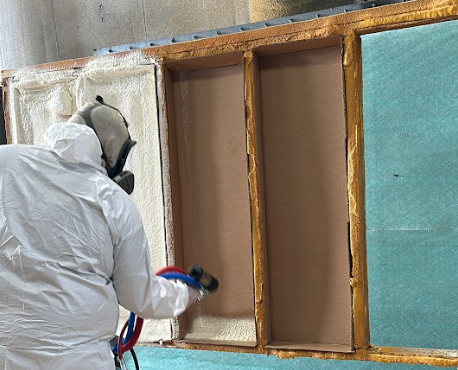Spray Polyurethane Foam Insulation Safe Use & Handling Guidelines

Spray Polyurethane Foam (SPF) insulation has become a popular choice for homeowners and builders due to its superior insulating properties, energy efficiency, and versatility. However, just like any chemically-based substance, it’s important that you handle it safely to protect yourself, your employees, and your customers.
The foam is headed and often sprayed indoors. This poses health and safety risks, due to while spraying and during transfer, especially for contractors and applicators working with these chemicals frequently.
We’ve put together some spray polyurethane foam insulation safety tips to minimize risk and exposure based on insights and recommendations from Bayer MaterialScience, a leading producer of polyurethane and polycarbonate materials.
Overexposure from Inhalation & Contact

The main risk for spray foam contractors is overexposure due to inhalation or contact with skin, eyes, and mouth. Too much exposure and contact with chemicals can lead to health risks including asthma, shortness of breath, coughing, sore throat, skin irritation, and more.
- Overexposure varies based on the specific spray foam products you’re using. Refer to the Material Safety Data Sheet (MSDS) for established occupational exposure limits and follow those recommendations.
- Ventilate the area as much as possible during and after spraying.
- Wear appropriate NIOSH-approved respiratory protection (usually a full face or hood air respirator)
- Wash hands after handling any chemicals.
- Wear additional recommended personal protective equipment, including coveralls with long sleeves, boots, gloves, and safety goggles.
Fire
Spray polyurethane foam will burn under certain conditions, so it’s important to take cautions and minimize heat and fire risks.
- Do not smoke near foam.
- Do not use space heaters near foam.
- Minimize heat generation by allowing appropriate time between spraying.
- Thoroughly inspect equipment before use to ensure connections are tight and other wires and connections are in good condition.
Spills & Leaks
Spills and leaks can happen. It’s important to have a plan in place to safely and quickly respond to these incidents and minimize accidental overexposure, property damage, and other issues.
- Clear the area except for those cleaning up the spill.
- Clean-up process can vary depending on the product you’re using. Follow instructions on the MSDS as indicated.
- Make sure you’re wearing all PPE when responding to the spill.
- Add additional ventilation to the room/building if possible.
- Notify management and other appropriate agencies, such as the Environmental Protection Agency or state groups.
Transporting Foam & Waste

Spray foam drums and equipment can be heavy. You should use caution to avoid injury to feet, eyes, back, and arms in case of accidental drops, slipping, or shifting.
- Wear steel-toed shoes to protect your feet.
- Use appropriate equipment such as dollies and lift gates.
- Follow manufacturer guidelines for spray foam storage and containers to minimize chemical reactions.
- Ensure equipment and foam is cooled before touching.
- Dispose of waste following federal, state, and local guidelines.
Partner with Oak Ridge
Oak Ridge Foam & Coating Systems, Inc. is here to help keep you and your team safe. If you have questions or concerns while purchasing our products, don’t hesitate to reach out. We also offer a helpful spray foam application training program to ensure safe and appropriate use of all SPF products and equipment.
